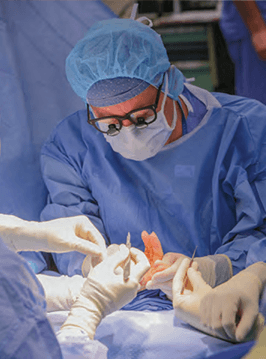Hand, Elbow, & Microvascular Surgery
Wrist Denervation

Dr. Melvin P. Rosenwasser Chief,
Hand, Elbow, and Microvascular Surgery
Our specialists in hand, elbow, and microvascular surgery routinely perform wrist denervation as a palliative approach to managing chronic wrist pain and as an adjunct to other procedures. This technique has evolved from more extensive denervations to more limited approaches preferred by our physicians.
Wrist denervation can delay or eliminate the need for more invasive and functionally limiting salvage procedures. Pain relief is achieved by resecting the nerve fibers that conduct pain from the wrist joint without interfering with any function of the hand. The wrist is protected in a splint for three to four weeks, and recovery of functional tasks is much easier than after traditional salvage wrist procedures, which distort the anatomy. A successful outcome is an 80 percent pain decrement, which results in high patient satisfaction rates.
Device Development
Our physicians have pioneered innovative solutions through medical technologies that are advancing the field of hand, elbow, and microvascular surgery and improving quality of life for patients.
-
Under development is a new device for simpler, stronger, and faster tendon repairs that uses stapling instead of standard suture-based techniques. Advantages of stapling repair include greater strength with less bulk that enhances tendon gliding and can permit earlier active motion rehabilitation, thereby lessening adhesion formation and repair failure. Strength of repair with a device that minimizes the potential for flexor tendon adhesions and the need for secondary surgery for tenolyses may increase the likelihood for successful repair of flexor tendons in the hand.
-
Current treatments for osteoarthritis of the thumb and fingers relieve pain but fail to restore full function and strength for patients. Our physicians and bioengineers, in collaboration with the Columbia Biomedical Technology Accelerator, have developed an implantable osteochondral allograft, which is curved to mimic the normal curvature of the joint. The cartilage replacement – called CartibendTM – may prove to be a true joint replacement in this common condition and replace the standard procedure of just resecting the arthritic bone.



